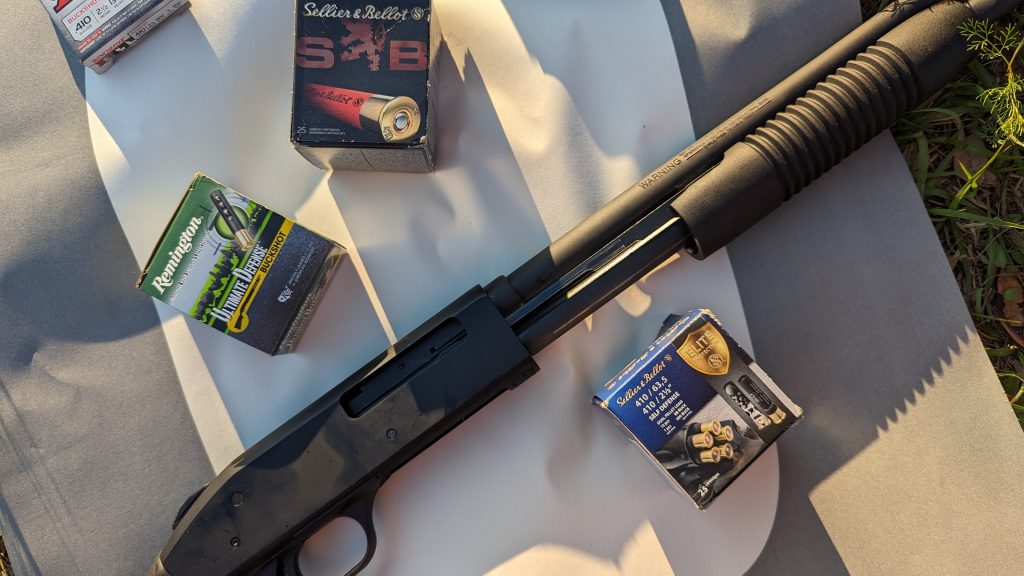
I love shotguns. I often write about shotguns, and they’re generally my favorite type of firearms. I like being able to throw eight pellets of 9mm per trigger pull at a threat. I appreciate their versatile design and the fact they can be a powerhouse at typical CONUS ranges.
As much as I love shotguns, especially the twelve gauge, I’ve found myself in an interesting conundrum. I hurt my right shoulder. I don’t know how and I don’t know when, but it feels pretty rough. Too rough for a 12 gauge shotgun, even a semi-auto gun with low recoil shells.
I already have a beat-up left shoulder that’s plagued with arthritis. I can see the writing on the wall that the 12 gauge might not always be the right thunderstick for me. With that in mind, I’ve begun searching for lower recoil options and have decided to try my hand at the .410. This started my quest to see if .410 would work for me and what the best defensive .410 option might be.
Why .410? I originally started with a 20 gauge, but after a few rounds of buckshot, my injured shoulder was aflame with pain. The .410, though, didn’t hurt that poor, injured shoulder of mine.
The Gun – Mossberg 590
With that in mind, I’m starting with a Mossberg 590 in .410. I wanted to start with a shotgun that I know works from a company I trust. Plus, there aren’t a ton of tactical shotgun options on the market that utilize the .410 load. This was one of the few factory-built options, and it seemed like a great place to start.
The Mossberg 590 .410 is a pump action design that holds seven rounds of 2.5-inch shells or six 3-inch shells.
The gun has an 18.5-inch barrel and comes with very basic polymer furniture. It’s drilled and tapped for a red dot. Unlike most 590s, the selection of aftermarket gear is a bit small, so attaching a light will be a creative endeavor.
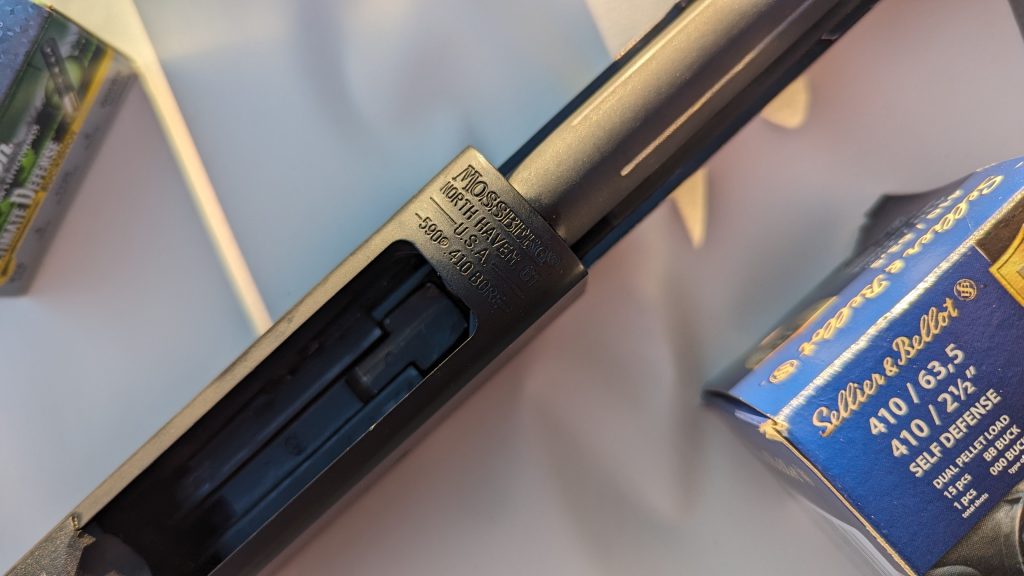
It’s lightweight, easy to use, and provides the same ergonomics I’m used to from my favorite pump action shotgun. This shotgun represents a bare-bones, basic option for defensive use.
The Mossberg 590 .410 is very lightweight and quite handy. Recoil is ultra-light overall and that makes the gun super easy to control.
I practiced with some defensive-oriented 5-pellet buckshot loads of the 3-inch variety and found I could put three rounds on target from the low ready in 1.87 seconds. That’s 15 9mm pellets in 1.87 seconds. That’s a complete GLOCK 19 magazine into the threat with every round aimed at and hitting the chest of the target.
I plan to experiment on a few other platforms in coming articles.
The Ammunition
I ran into my first problem in this series when shopping for .410 ammo. It’s tough to find. Ammo To Go was nice enough to help sponsor this endeavor and hooked me up with a ton of .410 ammo. It was a huge help. Setting up ammo alerts helped, and I was able to acquire a fairly diverse collection of defensive .410 loads. The ammo here is buckshot.
With shotguns, slugs are fine, but if I wanted to launch a single projectile, I’d just go to a rifle. Birdshot is for birds, which leaves us with…buckshot.
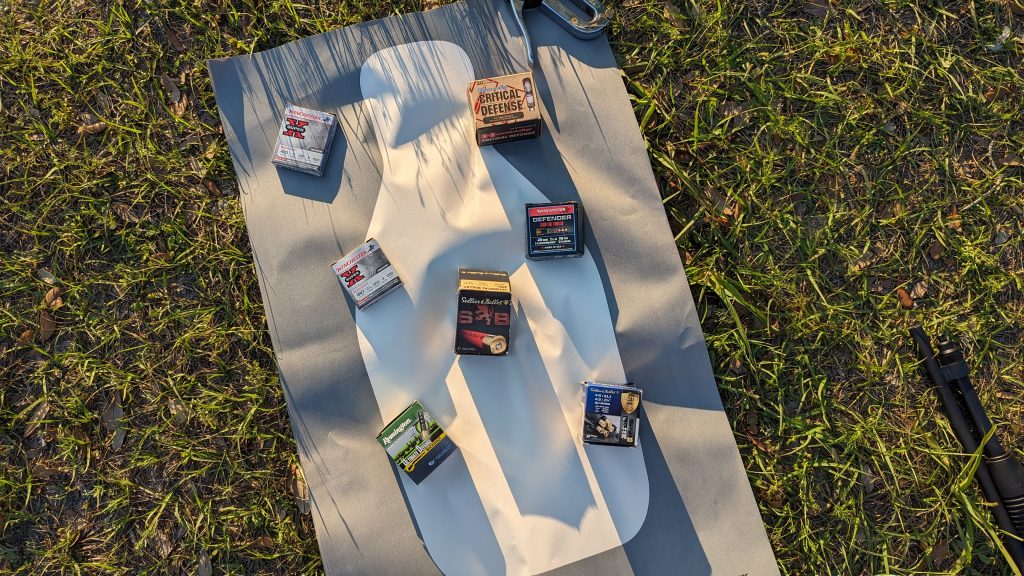
I acquired a few loads fo 2.5 and 3-inch options. I also included a few loads that were intended for the Taurus Judge just to round out the testing. I patterned each load multiple times at 10 yards on an FBI Q Target.
With a 12 gauge, my load of choice has traditionally been the Federal Fltiecontrol loads. They pattern tightly, perform reliably, and generally rule for home defense. There isn’t a Flitecontrol load in .410, so I had no idea of what would work best. I wanted a tight, consistent pattern that delivered excellent pellet accountability and reliable performance.
Let’s see how these loads patterned.
Remington Ultimate Defense
I was excited to see this load make a comeback. It disappeared for the longest time and then, out of nowhere, my local Bass Pro had some on hand. I left with a few boxes in a feast-or-famine mindset. This is a 3-inch load that’s packed with five pellets of 000 buckshot. It’s a handful and throws those five pellets at 1,135 feet per second.
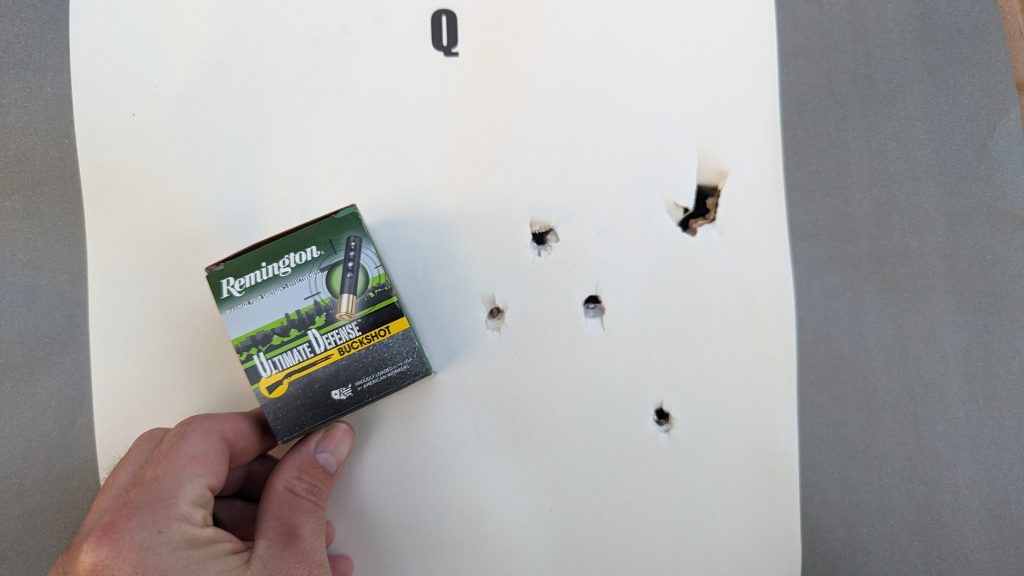
The load patterned decently well. Two pellets separate slightly from the main group, but not in a crazy or exaggerated manner. It’s fairly tight, and it would work at home defense ranges, though not mind-blowing by any means. The recoil was quite light, and the rounds cycled without a problem.
Sellier & Bellot Buckshot
This was a load I was able to find online that offered a fairly good price for .410 buckshot. It’s a five-pellet, 3-inch, 00 load sporting a velocity of 1,230 feet per second. We get 25 to a box, and it’s considered cheap for .410 at about $1.75 a round. How a cheap .410 load costs as much as a premium quality tactical 12 gauge buckshot round is beyond me.
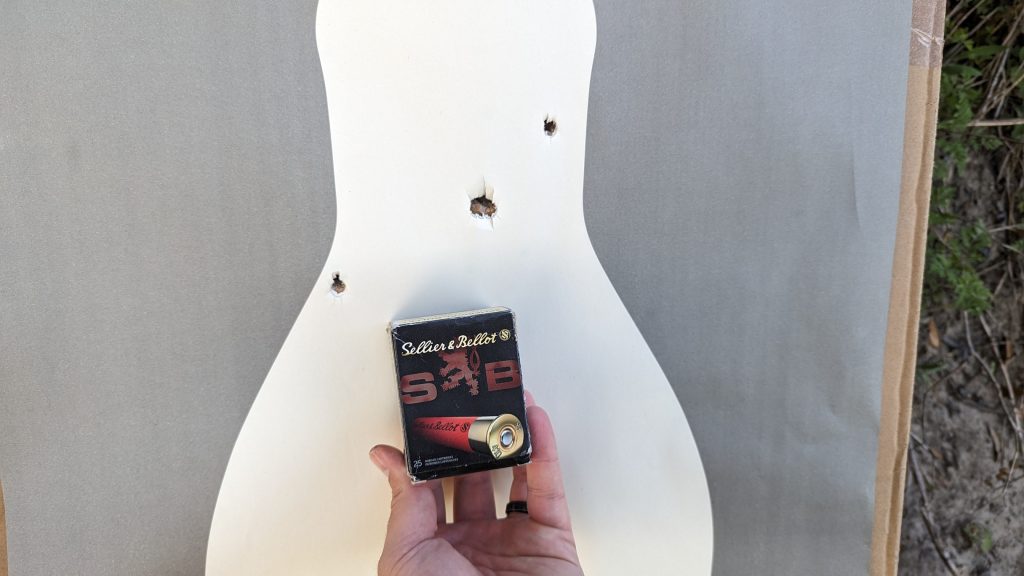
The recoil was very low, and the pattern was…interesting. It wasn’t terrible, but it was still fairly wide. Three of the pellets would always pattern well, but I would almost always have one and sometimes two flyers.
Aguila Buckshot
I had about half a box on hand of the Aguila high-velocity buckshot I had purchased years ago. It seems tough to find today. This is a 2.5-inch load, which means I get one more in my Mossberg 590. The round contains four oo pellets and it has a velocity of 1,275 feet per second. It’s fairly efficient for a 2.5 inch round.
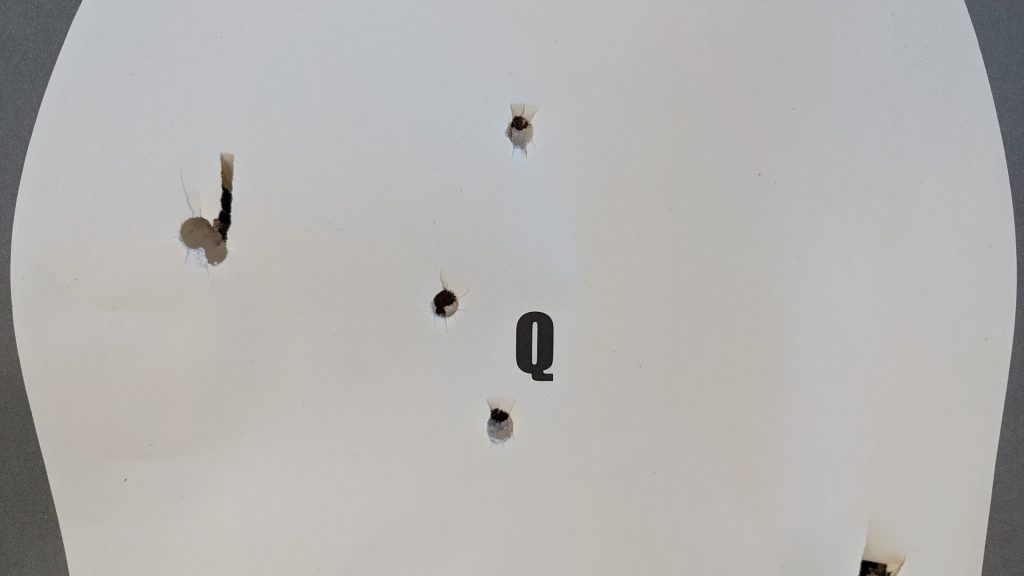
The pattern was surprisingly okay. Three pellets did consistently well with the occasional fourth pellet flyer. The pattern wasn’t fantastic, but it was adequate. Recoil was very low and performance was reliable.
Winchester Super X 3-inch
Winchester Super X was the easiest .410 buckshot to find. I ended up paying $3.00 a round for both the 3-inch and 2.5-inch. The 3-inch load is almost identical to the Remington load. It offers you five pellets of 000 buckshot moving at 1,135 feet per second.

The pattern is fairly tight. There’s a somewhat consistent fifth round flyer, and the pattern tends to string somewhat vertically. Recoil was mild, and reliability wasn’t a concern.
Winchester Super X 2.5 Inch
The Winchester Super X 2.5-inch load cuts our payload from five 000 balls to three. The load moves at 1,300 feet per second. The pattern is fairly consistent and quite tight overall. The wad is often the flyer, and we can see that on this target. Overall, this is a plain, but fairly solid option in the 2.5-inch variety.
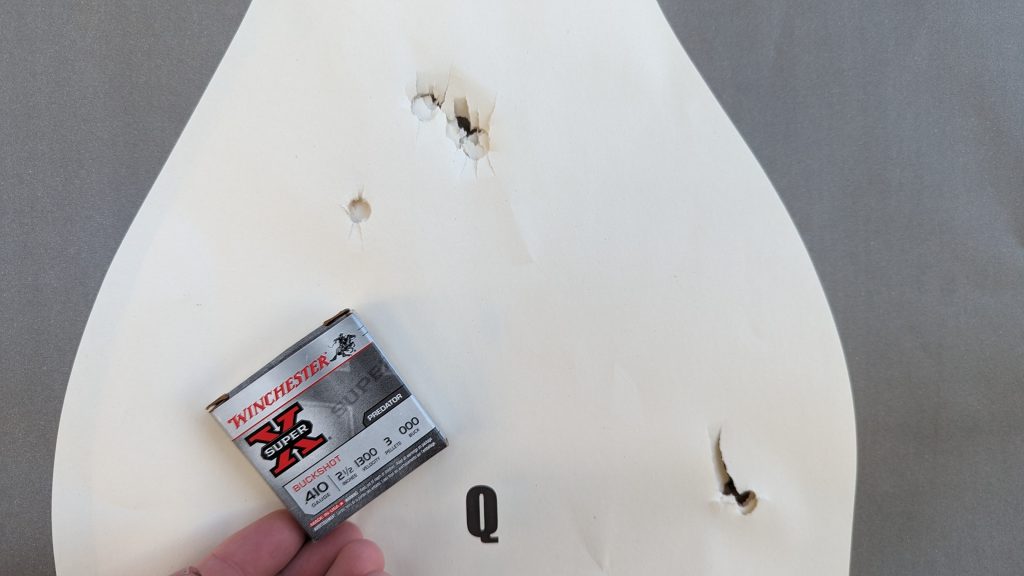
Hornady Critical Defense
The Hornady Critical Defense .410 was designed for .410 revolvers like the Judge and Smith & Wesson Governor. It’s an interesting load that mixes a .41 caliber FTX slug with two 000 balls. In a Judge, it’s a pretty decent round. I was curious how it stacked up in a smooth-bore shotgun. The reported velocity is 750 feet per second, but that’s measured from a revolver, not an 18.5-inch barrel.
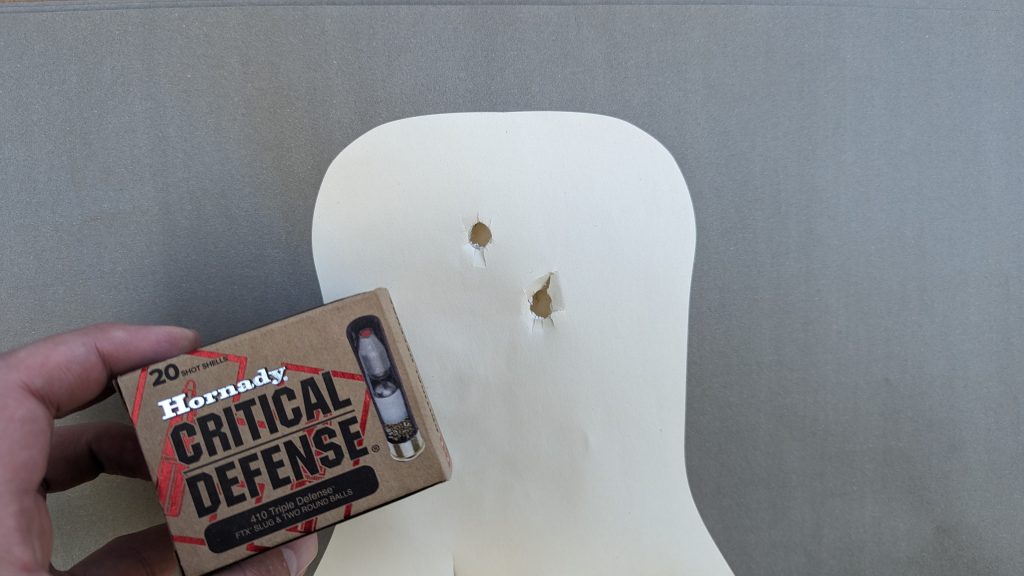
The three projectiles only made two holes. At first, I thought one might have missed, but upon further inspection, two of the projectiles must have been right on top of each other when they hit. Overall, the recoil was super mild.
Seller & Bellot Self Defense .410
This particular 3-inch load is aimed at the Judge as well. It shows a revolver cylinder on the box. The load promises one 000 buckshot pellet with 15 BB-sized pellets beneath it. From the start, I figured this was a crapshoot of a round, and I was right. The one ooo pellet hit perfectly under the Q where I was aiming. The 15 BBs went everywhere and were worthless. I doubt the BBs have the ability to penetrate very deeply or be very useful.

Winchester PDX .410
The Winchester PDX .410 is the final load and is another Judge-oriented round. It has three disks instead of pellets. Behind those three disks sit 12 BB-sized pellets. According to the box, it moves at 750 feet per second. The disks are cooper plated to avoid deformation.
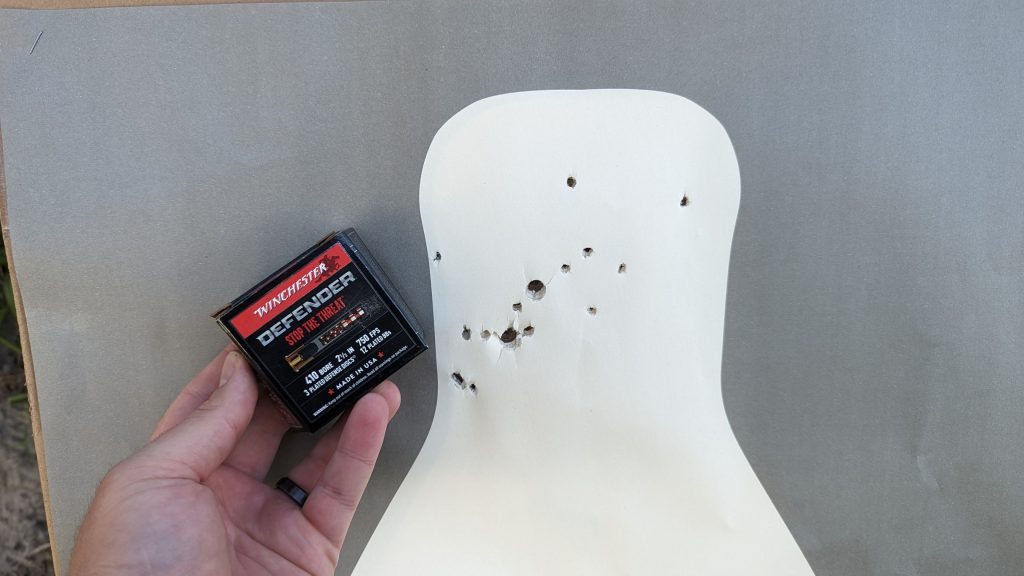
This load patterned better out of the Mossberg 590 than from any Judge I’ve ever used it in. The disks all landed close to each other, and the BBs remained contained in the head of the FBI Q Target. That’s not terrible, but the BBs are silly and offer no real advantage. At least they have the potential to be accounted-for projectiles. I honestly think this load would be much better if the BBs were totally removed. This load had the most recoil of any .410 load fired.
Ammo Conclusions
The .410 round has plenty of options available, but even the cheapest ones are expensive. I would probably go with the Remington Ultimate Defense loads for my favorite 3-inch option. The Winchester Super X performed well, but was three bucks a round compared to the less than $2 a round I paid for the Remington loads without a noticeable improvement.
For 2.5-inch loads the Hornady Critical Defense isn’t bad, but the FTX slug has been known to underpenetrate. The PDX load would be my pick if they ditched the BBs. Overall, I think the Winchester Super X 2.5-inch round takes the crown here.
One thing I consistently noticed was that three pellets of each load pattern tightly. If it was a five-pellet load three would be close, sometimes four. If it was a four-pellet load, again, three pellets would form the tightest pattern. The length and amount of pellets didn’t matter; three seem to be the magic number for a tight patterning load from .410.
None of these loads have copper plating. I think a dedicated defensive load should be copper-plated. This helps prevent deformation when the rounds are fired and can help produce a tighter pattern. The only copper-plated loads I fired were the Winchester PDX and those were disks, not pellets.
Overall, I think the .410 has real potential in a defensive rule and I would like to see what copper pellets could do. I also wonder how many number 1 pellets I could fit into a .410 shell.
Maybe I need to start loading my own ammo.

3 Responses
Nice article Mr. Pike
Sounds like hand loading might be the best option. 3pellets plated OOO might be the magic sauce. Now to find something close to a “flight control” wad.
Love 410, and I ain’t got any issues stopping me from using 12, I just like how light 410s are
Also I use remington UD when I don’t have hunting loads in
Nice read! Couple thoughts/items:
1) I don’t think 590’s come threaded for chokes? Having that done may allow you to achieve the pattern performance you’re looking for. Granted, having that done wouldn’t be cheap but I know Beretta makes a full line of chokes for .410. Get the threading and pick up the improved cylinder choke. The slight constricting of the IC choke could be the ticket. Not the results wanted? Grab the cylinder choke & you’re back to where you started.
2) Would have been cool if you had crono’ed the velocities to see what you were getting verses what was advertised on the box. Especially to see what velocities the 590 generated for the 2 handgun orientated rounds. (I know, chronographing shotguns is not easy & has a high ‘failure’ [didn’t register] rate. That and the danger of having the chronograph take pellets & get destroyed…)